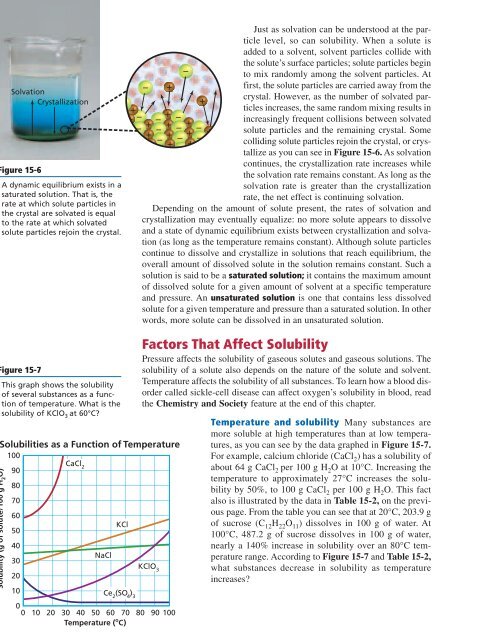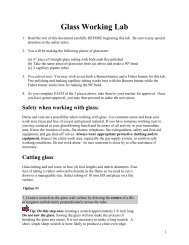Chapter 15: Solutions - Weironline.net
Chapter 15: Solutions - Weironline.net
Chapter 15: Solutions - Weironline.net
You also want an ePaper? Increase the reach of your titles
YUMPU automatically turns print PDFs into web optimized ePapers that Google loves.
Solubilities as a Function of Temperature<br />
100<br />
Solubility (g of solute/100 g H 2 O)<br />
Solvation<br />
Crystallization<br />
Figure <strong>15</strong>-6<br />
A dynamic equilibrium exists in a<br />
saturated solution. That is, the<br />
rate at which solute particles in<br />
the crystal are solvated is equal<br />
to the rate at which solvated<br />
solute particles rejoin the crystal.<br />
Figure <strong>15</strong>-7<br />
This graph shows the solubility<br />
of several substances as a function<br />
of temperature. What is the<br />
solubility of KClO 3 at 60°C?<br />
90<br />
80<br />
70<br />
60<br />
50<br />
40<br />
30<br />
20<br />
CaCl 2<br />
NaCl<br />
10<br />
0<br />
0 10 20 30 40 50 60 70 80 90 100<br />
Temperature ( o Ce2 (SO4 ) 3<br />
C)<br />
458 <strong>Chapter</strong> <strong>15</strong> <strong>Solutions</strong><br />
�<br />
KCl<br />
Just as solvation can be understood at the particle<br />
level, so can solubility. When a solute is<br />
added to a solvent, solvent particles collide with<br />
the solute’s surface particles; solute particles begin<br />
�<br />
to mix randomly among the solvent particles. At<br />
� �<br />
first, the solute particles are carried away from the<br />
crystal. However, as the number of solvated par-<br />
�<br />
�<br />
ticles increases, the same random mixing results in<br />
�<br />
� � � �<br />
increasingly frequent collisions between solvated<br />
� � �<br />
� � � � solute particles and the remaining crystal. Some<br />
� � � �<br />
� � �<br />
� � �<br />
colliding solute particles rejoin the crystal, or crystallize<br />
as you can see in Figure <strong>15</strong>-6. As solvation<br />
continues, the crystallization rate increases while<br />
the solvation rate remains constant. As long as the<br />
solvation rate is greater than the crystallization<br />
rate, the <strong>net</strong> effect is continuing solvation.<br />
Depending on the amount of solute present, the rates of solvation and<br />
crystallization may eventually equalize: no more solute appears to dissolve<br />
and a state of dynamic equilibrium exists between crystallization and solvation<br />
(as long as the temperature remains constant). Although solute particles<br />
continue to dissolve and crystallize in solutions that reach equilibrium, the<br />
overall amount of dissolved solute in the solution remains constant. Such a<br />
solution is said to be a saturated solution; it contains the maximum amount<br />
of dissolved solute for a given amount of solvent at a specific temperature<br />
and pressure. An unsaturated solution is one that contains less dissolved<br />
solute for a given temperature and pressure than a saturated solution. In other<br />
words, more solute can be dissolved in an unsaturated solution.<br />
Factors That Affect Solubility<br />
Pressure affects the solubility of gaseous solutes and gaseous solutions. The<br />
solubility of a solute also depends on the nature of the solute and solvent.<br />
Temperature affects the solubility of all substances. To learn how a blood disorder<br />
called sickle-cell disease can affect oxygen’s solubility in blood, read<br />
the Chemistry and Society feature at the end of this chapter.<br />
KClO 3<br />
Temperature and solubility Many substances are<br />
more soluble at high temperatures than at low temperatures,<br />
as you can see by the data graphed in Figure <strong>15</strong>-7.<br />
For example, calcium chloride (CaCl 2 ) has a solubility of<br />
about 64 g CaCl 2 per 100 g H 2 O at 10°C. Increasing the<br />
temperature to approximately 27°C increases the solubility<br />
by 50%, to 100 g CaCl 2 per 100 g H 2 O. This fact<br />
also is illustrated by the data in Table <strong>15</strong>-2, on the previous<br />
page. From the table you can see that at 20°C, 203.9 g<br />
of sucrose (C 12 H 22 O 11 ) dissolves in 100 g of water. At<br />
100°C, 487.2 g of sucrose dissolves in 100 g of water,<br />
nearly a 140% increase in solubility over an 80°C temperature<br />
range. According to Figure <strong>15</strong>-7 and Table <strong>15</strong>-2,<br />
what substances decrease in solubility as temperature<br />
increases?




